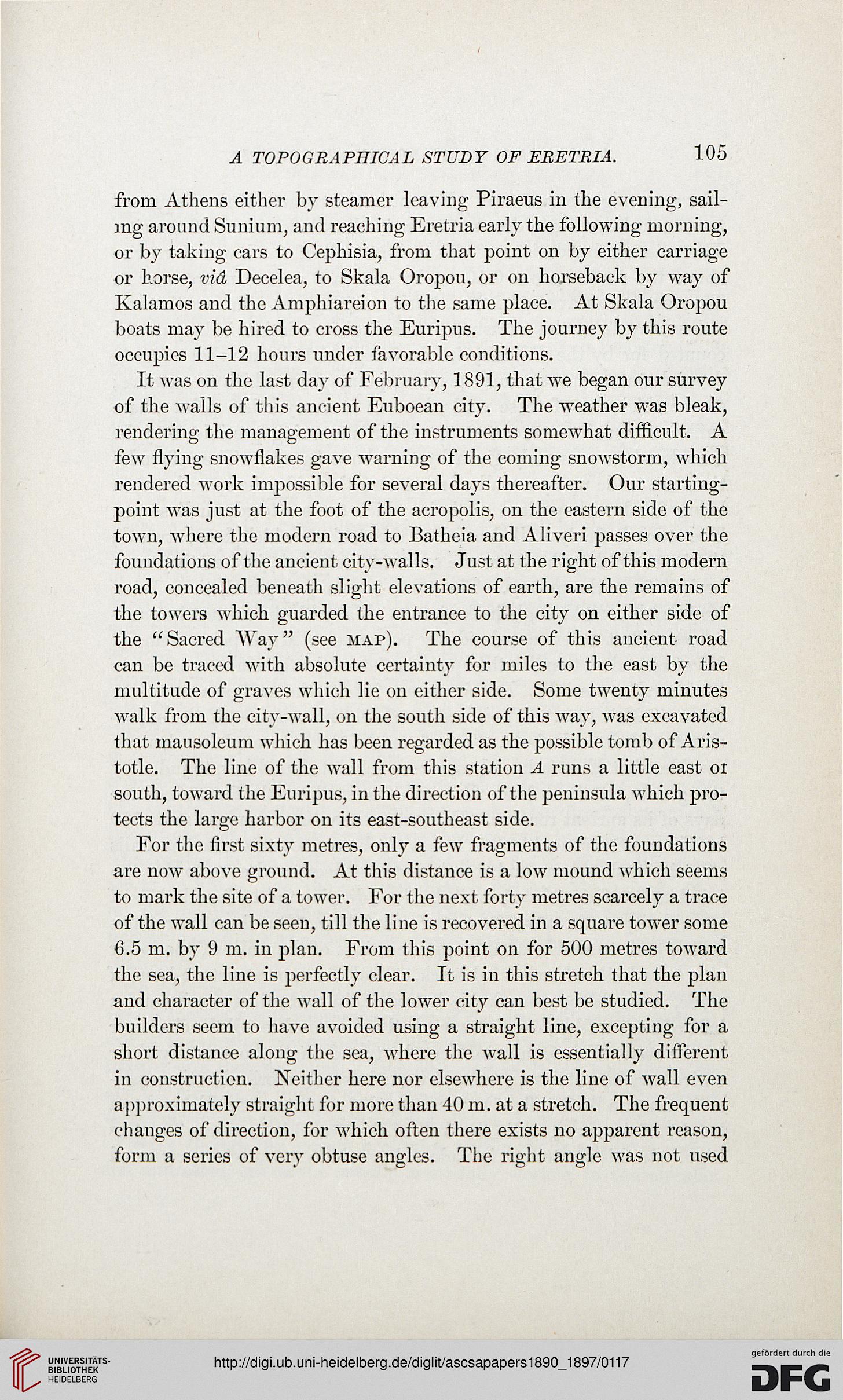A TOPOGRAPHICAL STUDY OF ERETRIA.
105
from Athens either by steamer leaving Piraeus in the evening, sail-
ing around Sunium, and reaching Eretria early the following morning,
or by taking cars to Cephisia, from that point on by either carriage
or horse, vid Decelea, to Skala Oropou, or on horseback by way of
Kalamos and the Amphiareion to the same place. At Skala Oropou
boats may be hired to cross the Euripus. The journey by this route
occupies 11-12 hours under favorable conditions.
It was on the last day of February, 1891, that we began our survey
of the walls of this ancient Euboean city. The weather was bleak,
rendering the management of the instruments somewhat difficult. A
few flying snowflakes gave warning of the coming snowstorm, which
rendered work impossible for several days thereafter. Our starting-
point w7as just at the foot of the acropolis, on the eastern side of the
town, where the modern road to Batheia and Aliveri passes over the
foundations of the ancient city-walls. Just at the right of this modern
road, concealed beneath slight elevations of earth, are the remains of
the towers which guarded the entrance to the city on either side of
the "Sacred Way" (see map). The course of this ancient road
can be traced with absolute certainty for miles to the east by the
multitude of graves which lie on either side. Some twenty minutes
walk from the city-wall, on the south side of this way, was excavated
that mausoleum which has been regarded as the possible tomb of Aris-
totle. The line of the wall from this station A runs a little east oi
south, toward the Euripus, in the direction of the peninsula which pro-
tects the large harbor on its east-southeast side.
For the first sixty metres, only a few fragments of the foundations
are now above ground. At this distance is a low mound which seems
to mark the site of a tower. For the next forty metres scarcely a trace
of the wall can be seen, till the line is recovered in a square tower some
6.5 m. by 9 m. in plan. From this point on for 500 metres toward
the sea, the line is iierfectly clear. It is in this stretch that the plan
and character of the wall of the lower city can best be studied. The
builders seem to have avoided using a straight line, excepting for a
short distance along the sea, where the wall is essentially different
in construction. Neither here nor elsewhere is the line of wall even
approximately straight for more than 40 m. at a stretch. The frequent
changes of direction, for which often there exists no apparent reason,
form a series of very obtuse angles. The right angle was not used
105
from Athens either by steamer leaving Piraeus in the evening, sail-
ing around Sunium, and reaching Eretria early the following morning,
or by taking cars to Cephisia, from that point on by either carriage
or horse, vid Decelea, to Skala Oropou, or on horseback by way of
Kalamos and the Amphiareion to the same place. At Skala Oropou
boats may be hired to cross the Euripus. The journey by this route
occupies 11-12 hours under favorable conditions.
It was on the last day of February, 1891, that we began our survey
of the walls of this ancient Euboean city. The weather was bleak,
rendering the management of the instruments somewhat difficult. A
few flying snowflakes gave warning of the coming snowstorm, which
rendered work impossible for several days thereafter. Our starting-
point w7as just at the foot of the acropolis, on the eastern side of the
town, where the modern road to Batheia and Aliveri passes over the
foundations of the ancient city-walls. Just at the right of this modern
road, concealed beneath slight elevations of earth, are the remains of
the towers which guarded the entrance to the city on either side of
the "Sacred Way" (see map). The course of this ancient road
can be traced with absolute certainty for miles to the east by the
multitude of graves which lie on either side. Some twenty minutes
walk from the city-wall, on the south side of this way, was excavated
that mausoleum which has been regarded as the possible tomb of Aris-
totle. The line of the wall from this station A runs a little east oi
south, toward the Euripus, in the direction of the peninsula which pro-
tects the large harbor on its east-southeast side.
For the first sixty metres, only a few fragments of the foundations
are now above ground. At this distance is a low mound which seems
to mark the site of a tower. For the next forty metres scarcely a trace
of the wall can be seen, till the line is recovered in a square tower some
6.5 m. by 9 m. in plan. From this point on for 500 metres toward
the sea, the line is iierfectly clear. It is in this stretch that the plan
and character of the wall of the lower city can best be studied. The
builders seem to have avoided using a straight line, excepting for a
short distance along the sea, where the wall is essentially different
in construction. Neither here nor elsewhere is the line of wall even
approximately straight for more than 40 m. at a stretch. The frequent
changes of direction, for which often there exists no apparent reason,
form a series of very obtuse angles. The right angle was not used




